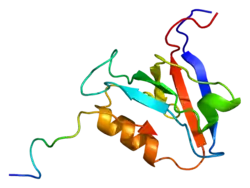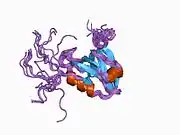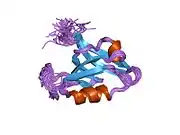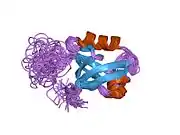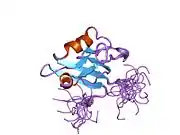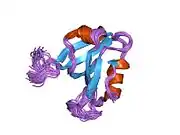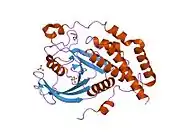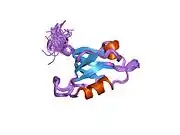PTPN13
Tyrosine-protein phosphatase non-receptor type 13 is an enzyme that in humans is encoded by the PTPN13 gene.[5][6]
The protein encoded by this gene is a member of the protein tyrosine phosphatase (PTP) family. PTPs are known to be signaling molecules that regulate a variety of cellular processes including cell growth, differentiation, mitotic cycle, and oncogenic transformation. This PTP is a large protein that possesses a PTP domain at C-terminus, and multiple noncatalytic domains, which include a domain with similarity to band 4.1 superfamily of cytoskeletal-associated proteins, a region consisting of five PDZ domains, and a leucine zipper motif. This PTP was found to interact with, and dephosphorylate Fas receptor, as well as IkappaBalpha through the PDZ domains, which suggested its role in Fas mediated programmed cell death. This PTP was also shown to interact with GTPase-activating protein, and thus may function as a regulator of Rho signaling pathway. Four alternatively spliced transcript variants, which encode distinct proteins, have been reported.[6]
References
- GRCh38: Ensembl release 89: ENSG00000163629 - Ensembl, May 2017
- GRCm38: Ensembl release 89: ENSMUSG00000034573 - Ensembl, May 2017
- "Human PubMed Reference:". National Center for Biotechnology Information, U.S. National Library of Medicine.
- "Mouse PubMed Reference:". National Center for Biotechnology Information, U.S. National Library of Medicine.
- Maekawa K, Imagawa N, Nagamatsu M, Harada S (Feb 1994). "Molecular cloning of a novel protein-tyrosine phosphatase containing a membrane-binding domain and GLGF repeats". FEBS Lett. 337 (2): 200–206. doi:10.1016/0014-5793(94)80273-4. PMID 8287977. S2CID 46269697.
- "Entrez Gene: PTPN13 protein tyrosine phosphatase, non-receptor type 13 (APO-1/CD95 (Fas)-associated phosphatase)".
- Gross, C; Heumann R; Erdmann K S (May 2001). "The protein kinase C-related kinase PRK2 interacts with the protein tyrosine phosphatase PTP-BL via a novel PDZ domain binding motif". FEBS Lett. 496 (2–3): 101–104. doi:10.1016/S0014-5793(01)02401-2. ISSN 0014-5793. PMID 11356191. S2CID 205880882.
Further reading
- Sato T, Irie S, Kitada S, Reed JC (1995). "FAP-1: a protein tyrosine phosphatase that associates with Fas". Science. 268 (5209): 411–415. Bibcode:1995Sci...268..411S. doi:10.1126/science.7536343. PMID 7536343.
- Saras J, Claesson-Welsh L, Heldin CH, Gonez LJ (1994). "Cloning and characterization of PTPL1, a protein tyrosine phosphatase with similarities to cytoskeletal-associated proteins". J. Biol. Chem. 269 (39): 24082–9. PMID 7929060.
- Banville D, Ahmad S, Stocco R, Shen SH (1994). "A novel protein-tyrosine phosphatase with homology to both the cytoskeletal proteins of the band 4.1 family and junction-associated guanylate kinases". J. Biol. Chem. 269 (35): 22320–7. PMID 8071359.
- Inazawa J, Ariyama T, Abe T, et al. (1997). "PTPN13, a fas-associated protein tyrosine phosphatase, is located on the long arm of chromosome 4 at band q21.3". Genomics. 31 (2): 240–242. doi:10.1006/geno.1996.0039. PMID 8824809.
- Yanagisawa J, Takahashi M, Kanki H, et al. (1997). "The molecular interaction of Fas and FAP-1. A tripeptide blocker of human Fas interaction with FAP-1 promotes Fas-induced apoptosis". J. Biol. Chem. 272 (13): 8539–8545. doi:10.1074/jbc.272.13.8539. PMID 9079683.
- Saras J, Engström U, Góñez LJ, Heldin CH (1997). "Characterization of the interactions between PDZ domains of the protein-tyrosine phosphatase PTPL1 and the carboxyl-terminal tail of Fas". J. Biol. Chem. 272 (34): 20979–20981. doi:10.1074/jbc.272.34.20979. PMID 9261095.
- Saras J, Franzén P, Aspenström P, et al. (1997). "A novel GTPase-activating protein for Rho interacts with a PDZ domain of the protein-tyrosine phosphatase PTPL1". J. Biol. Chem. 272 (39): 24333–24338. doi:10.1074/jbc.272.39.24333. PMID 9305890.
- Ekiel I, Banville D, Shen SH, et al. (1999). "Main-chain signal assignment for the PDZ2 domain from human protein tyrosine phosphatase hPTP1E and its complex with a C-terminal peptide from the Fas receptor". J. Biomol. NMR. 12 (3): 455–456. doi:10.1023/A:1008267807859. PMID 9835052. S2CID 19976473.
- Maekawa K, Imagawa N, Naito A, et al. (1999). "Association of protein-tyrosine phosphatase PTP-BAS with the transcription-factor-inhibitory protein IkappaBalpha through interaction between the PDZ1 domain and ankyrin repeats". Biochem. J. 337 (2): 179–84. doi:10.1042/0264-6021:3370179. PMC 1219950. PMID 9882613.
- Lin D, Gish GD, Songyang Z, Pawson T (1999). "The carboxyl terminus of B class ephrins constitutes a PDZ domain binding motif". J. Biol. Chem. 274 (6): 3726–3733. doi:10.1074/jbc.274.6.3726. PMID 9920925.
- Murthy KK, Clark K, Fortin Y, et al. (1999). "ZRP-1, a zyxin-related protein, interacts with the second PDZ domain of the cytosolic protein tyrosine phosphatase hPTP1E". J. Biol. Chem. 274 (29): 20679–20687. doi:10.1074/jbc.274.29.20679. PMID 10400701.
- Cuppen E, van Ham M, Pepers B, et al. (1999). "Identification and molecular characterization of BP75, a novel bromodomain-containing protein". FEBS Lett. 459 (3): 291–298. doi:10.1016/S0014-5793(99)01191-6. PMID 10526152. S2CID 41216030.
- Irie S, Hachiya T, Rabizadeh S, et al. (1999). "Functional interaction of Fas-associated phosphatase-1 (FAP-1) with p75(NTR) and their effect on NF-kappaB activation". FEBS Lett. 460 (2): 191–198. doi:10.1016/S0014-5793(99)01324-1. PMID 10544233. S2CID 25143664.
- Lee SH, Shin MS, Park WS, et al. (2000). "Immunohistochemical localization of FAP-1, an inhibitor of Fas-mediated apoptosis, in normal and neoplastic human tissues". APMIS. 107 (12): 1101–1108. doi:10.1111/j.1699-0463.1999.tb01515.x. PMID 10660140. S2CID 24672576.
- Kozlov G, Gehring K, Ekiel I (2000). "Solution structure of the PDZ2 domain from human phosphatase hPTP1E and its interactions with C-terminal peptides from the Fas receptor". Biochemistry. 39 (10): 2572–2580. doi:10.1021/bi991913c. PMID 10704206.
- Cuppen E, van Ham M, Wansink DG, et al. (2000). "The zyxin-related protein TRIP6 interacts with PDZ motifs in the adaptor protein RIL and the protein tyrosine phosphatase PTP-BL". Eur. J. Cell Biol. 79 (4): 283–293. doi:10.1078/S0171-9335(04)70031-X. PMID 10826496.
- Erdmann KS, Kuhlmann J, Lessmann V, et al. (2000). "The Adenomatous Polyposis Coli-protein (APC) interacts with the protein tyrosine phosphatase PTP-BL via an alternatively spliced PDZ domain". Oncogene. 19 (34): 3894–3901. doi:10.1038/sj.onc.1203725. PMID 10951583.
- Nakai Y, Irie S, Sato TA (2001). "Identification of IkappaBalpha as a substrate of Fas-associated phosphatase-1". Eur. J. Biochem. 267 (24): 7170–7175. doi:10.1046/j.1432-1327.2000.01818.x. PMID 11106428.
- Gross C, Heumann R, Erdmann KS (2001). "The protein kinase C-related kinase PRK2 interacts with the protein tyrosine phosphatase PTP-BL via a novel PDZ domain binding motif". FEBS Lett. 496 (2–3): 101–104. doi:10.1016/S0014-5793(01)02401-2. PMID 11356191. S2CID 205880882.
